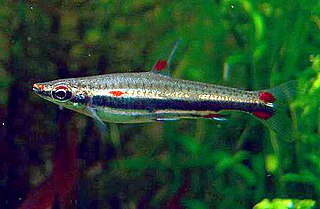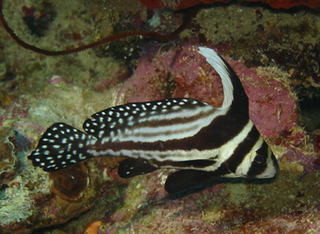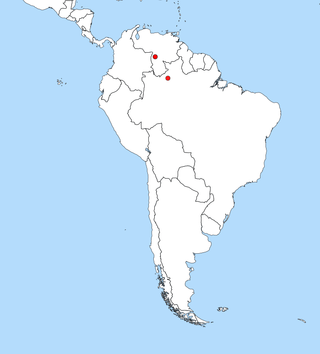
In taxonomy, binomial nomenclature, also called binary nomenclature, is a formal system of naming species of living things by giving each a name composed of two parts, both of which use Latin grammatical forms, although they can be based on words from other languages. Such a name is called a binomial name, a binomen, binominal name, or a scientific name; more informally it is also historically called a Latin name. In the ICZN, the system is also called binominal nomenclature, "binomi'N'al" with an "N" before the "al", which is not a typographic error, meaning "two-name naming system".

Cobitidae, also known as the True loaches, is a family of Old World freshwater fish. They occur throughout Eurasia and in Morocco, and inhabit riverine ecosystems. Today, most "loaches" are placed in other families. The family includes about 260 described species. New species are being described regularly.

The leafy seadragon or Glauert's seadragon, is a marine fish. It is the only member of the genus Phycodurus in the family Syngnathidae, which includes seadragons, pipefish, and seahorses.

Nannostomus is a genus of fish belonging to the characin family Lebiasinidae. All of the species in this genus are known as pencil fish, a popular name that was initially only applied to two species in the 1920s, Nannostomus unifasciatus and Nannostomus eques, by the late 1950s however, the term would be applied to all members of the genus. Several species have become popular aquarium fish due to their attractive coloration, unique shape, and interesting demeanor.

The Sillaginidae, commonly known as the smelt-whitings, whitings, sillaginids, sand borers and sand-smelts, are a family of benthic coastal marine fish historically classified in the order Perciformes, although the 5th edition of Fishes of the World places the family in the Spariformes. The smelt-whitings inhabit a wide region covering much of the Indo-Pacific, from the west coast of Africa east to Japan and south to Australia. The family comprises only five genera and 35 species, of which a number are dubious, with the last major revision of the family in 1992 unable to confirm the validity of a number of species. They are elongated, slightly compressed fish, often light brown to silver in colour, with a variety of markings and patterns on their upper bodies. The Sillaginidae are not related to a number of fishes commonly called 'whiting' in the Northern Hemisphere, including the fish originally called whiting, Merlangius merlangus.

The spotted drum or spotted ribbonfish, is a species of marine ray-finned fish belonging to the family Sciaenidae, the drums and croakers. This species is found in the western Atlantic Ocean.

Nannostomus trifasciatus,, commonly known as the three-lined or three-stripe pencilfish, is a freshwater species of fish belonging to the characin family Lebiasinidae. They are popular in the aquarium trade due to their small size, beautiful color pattern, and relative hardiness.

The northern whiting, also known as the silver whiting and sand smelt, is a marine fish, the most widespread and abundant member of the smelt-whiting family Sillaginidae. The northern whiting was the first species of sillaginid scientifically described and is therefore the type species of both the family Sillaginidae and the genus Sillago. The species is distributed in the Indo-Pacific region from South Africa in the west to Japan and Indonesia in the east. The northern whiting inhabits coastal areas to 60 m, but is most often found in shallow water around bays and estuaries, often entering freshwater. It is a carnivore, taking a variety of polychaetes and crustaceans. The species is of major economic importance throughout the Indo-Pacific. It is most frequently taken by seine nets and cast nets and marketed fresh.
Nannostomus harrisoni,, is a species of pencil fish. Native to The Guianas, the species displays a single horizontal stripe of intense black, and blood red adornments on its fins. N. harrisoni is often confused with Nannostomus unifasciatus, another long, slender, single-striped species with similar profile and coloration, but N. harrisoni swims in a horizontal posture, as opposed to the snout-up oblique posture of N.unifasciatus, and the bright red adornments on the ventral fins of N. harrisoni are absent in N. unifasciatus. Though the recently described species N. grandis has been dubbed the largest member of the genus, adults of N. harrisoni commonly grow to a length of 70 mm, making it in fact the largest species of pencil fish described to date. It is commonly known as Harrison's pencilfish.

The jack-knifefish is a species of marine ray-finned fish belonging to the family Sciaenidae, the drums and croakers. It is native to the western Atlantic Ocean, where its distribution extends along the eastern coasts of the Americas from the Carolinas in the United States to Brazil, including the Caribbean. Other common names include donkey fish and lance-shaped ribbonfish.

Nannostomus anduzei is a freshwater species of fish belonging to the genus Nannostomus in the characin family Lebiasinidae. It is native to Venezuela and northern Brazil, particularly the upper Orinoco and Rio Ererê, a tributary of the Rio Negro. The adults grow to a maximum length of only 16 mm, making them one of the smallest pencilfish. Other common names include miniature pencilfish, miniature nannostomus, and Anduzi's nannostomus.

Nannostomus beckfordi,, commonly known as the golden pencil fish or Beckford's pencil fish, is a freshwater species of fish belonging to the characin family Lebiasinidae. It occurs widely and commonly in swamps and slow-moving waters in Brazil, Guyana, French Guiana, and Suriname.

Nannostomus bifasciatus,, is a freshwater species of fish belonging to the characin family Lebiasinidae. It is commonly known as the two-lined pencilfish. It can be found in slow-moving swamps and rivers in French Guiana and Suriname.
Nannostomus britskii,, commonly known as the spotstripe pencilfish, is a freshwater species of fish belonging to the family Lebiasinidae of characins. They were first described in 1978 by Stanley H. Weitzman along with two other new species, from a collection of specimens preserved in the São Paulo museum. They have been recorded from only two localities, both in Brazil. No live specimens had been seen, collected, or exported for the aquarium trade until very recently.
Nannostomus digrammus,, commonly known as the twostripe pencilfish, is a freshwater species of fish belonging to the characin family Lebiasinidae. They were first described in 1913 by Henry Weed Fowler and are fairly typical of members of this genus being small, elongated fish with prominent horizontal stripes, in this case limited to two dominant stripes, usually maroon in color. They are recorded as native to Brazil and Guyana, where they occur fairly widely, but are seen only occasionally in the aquarium trade.

Nannostomus espei,, commonly known as Espe's pencilfish or barred pencilfish, is a freshwater species of fish belonging to the characin family Lebiasinidae. It was first described in 1956 by Herman Meinken from the Mazaruni River system in Guyana and to date this is its only known location. It is notable amongst the genus in that the dominant body pattern consists of five broad, comma-like patches instead of the more normal horizontal stripes seen in the rest of the genus. This pattern of patches is assumed by other species at night, but only N. espei displays the pattern permanently and in daylight.

Nannostomus limatus,, commonly known as the elegant pencilfish, is a freshwater species of fish belonging to the characin family Lebiasinidae. They were first described in 1978 by Stanley H. Weitzman along with two other new species, from a collection of specimens preserved in the São Paulo museum. Only rarely imported and kept by aquarists, they have been recorded from the Amazonian region of Brazil, specifically near Santarém.

Nannostomus marginatus,, commonly known as the dwarf pencilfish, is a freshwater species of fish belonging to the genus Nannostomus in the characin family Lebiasinidae. They were first described in 1909 by C. H. Eigenmann and are typical of members of this genus being small, elongated fish with prominent horizontal stripes. The most notable feature of N. marginatus is its size, it being one of the smallest members of the genus, only reaching a maximum size of 35 mm. They occur widely on the South American continent having been recorded in Brazil, Guyana, Colombia, Suriname, and Peru, and have been a popular aquarium species since their introduction to aquarists in the early twentieth century.

Nannostomus minimus,, commonly known as the least pencilfish, is a freshwater species of fish belonging to the characin family Lebiasinidae. It is restricted to Guyana, where it has been reported from the Potaro and Mazaruni Rivers.

Nannostomus unifasciatus,, commonly known as the one-lined pencilfish, is a freshwater species of fish belonging to the genus Nannostomus in the characin family Lebiasinidae. They are popular in the aquarium trade due to their small size, beautiful color pattern, unique swimming posture and relative hardiness. With its long, pencil-shaped profile, its single jet black stripe reminiscent of the graphite core of a pencil, and its eraser-colored caudal fin, this is the species for which the popular name, 'pencilfish', was first coined in the 1920s, later to be applied to all the species of the genus Nannostomus.
















